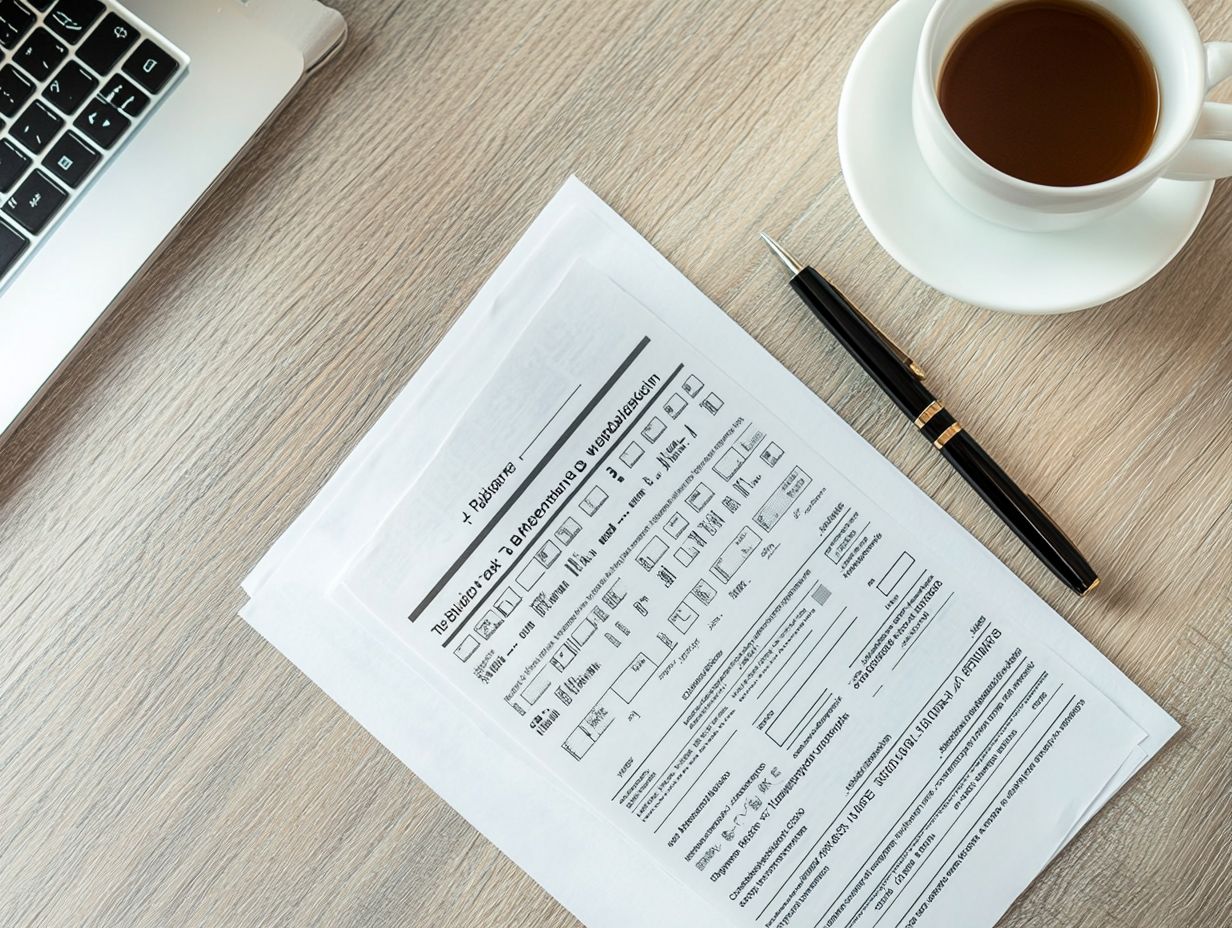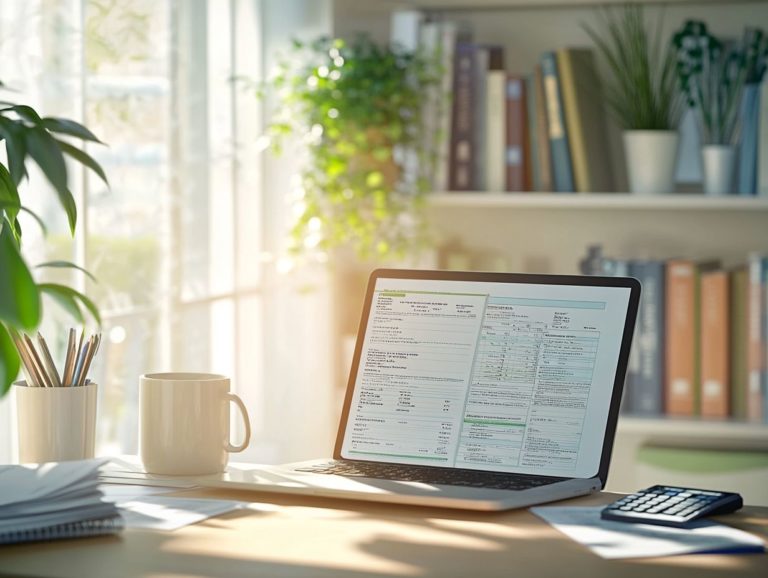Understanding Self-Employment Taxes: What You Need to Know
Self-employment is an exciting journey, but it comes with its challenges, especially when dealing with taxes. Self-employment taxes might seem daunting at first. Grasping these obligations is essential for every entrepreneur or freelancer. This guide simplifies the critical elements, including various tax types, calculations, crucial deadlines, and valuable deductions you may not even realize you’re eligible for.
Armed with strategies for effective management, you’ll be well-prepared to tackle your self-employment tax responsibilities with confidence and poise.
Contents
Key Takeaways:

- Self-employment taxes consist of income tax and self-employment tax, and are paid by self-employed individuals.
- Calculating self-employment taxes involves understanding income tax brackets, rates, and deductions, as well as the self-employment tax rate.
- To effectively manage self-employment taxes, it is important to keep organized records and consider working with a tax professional for guidance and assistance.
What are Self-Employment Taxes?
Self-employment taxes represent a vital financial responsibility for individuals like you who are self-employed. These taxes encompass both Medicare and Social Security contributions, essential for maintaining key federal programs and benefits. They re calculated based on your net earnings from self-employment, ensuring that you, as an independent contractor or sole proprietor, meet your obligations to the federal government while securing your future access to social security benefits.
Understanding these taxes is crucial as they have a direct impact on your net profits and tax filings throughout the year. The components of self-employment taxes can significantly affect your net income as someone navigating an independent career. When you calculate your taxes, it s important to factor in the 15.3% self-employment tax rate, which breaks down to 12.4% for Social Security and 2.9% for Medicare.
This financial obligation stems from the necessity of maintaining coverage under these federal programs, which are critical for healthcare and retirement support. Compliance with tax reporting requirements is imperative; accurate filings can save you from penalties and ensure that you retain access to the benefits earned through years of hard work.
By grasping the implications of these taxes, you empower yourself to make informed financial decisions and strategically plan for a prosperous future.
Types of Self-Employment Taxes
Self-employment taxes encompass two main categories: income tax and self-employment tax. Each serves a unique purpose for self-employed individuals and business owners, ensuring that your contributions align with your earnings and entrepreneurial efforts.
Income Tax
Income tax is a required payment imposed on your taxable income, including that from self-employment, and it can profoundly influence your overall financial well-being.
For those who are self-employed, the journey to accurately calculating income tax starts with meticulous reporting of taxable income, which encompasses earnings from various sources. Your Adjusted Gross Income (AGI) is your total income minus specific deductions, and it is equally vital for determining your eligibility for various tax deductions and credits.
These deductions such as business expenses, health insurance premiums, and contributions to retirement accounts can significantly lower your tax liability. It s crucial for you to keep detailed records of your expenditures to maximize these benefits.
When it s time to file, self-employed individuals typically turn to Form 1040 along with Schedule C to outline their business income and expenses. This approach not only ensures compliance with tax laws but also optimizes your financial outcomes.
Self-Employment Tax
The self-employment tax is a specific tax that applies to you, the self-employed individual, primarily covering Social Security and Medicare taxes. It’s calculated based on your net earnings the money you keep after all business expenses are deducted.
Typically, this tax rate stands at 15.3%. It breaks down to 12.4% for Social Security and 2.9% for Medicare. Understanding how this tax functions is crucial since it directly impacts your future benefits, including retirement.
Since you don t have an employer withholding these taxes for you, estimating your tax liabilities and making quarterly payments is essential. This proactive approach helps you avoid hefty year-end penalties. Keeping a close eye on these obligations plays a significant role in your financial planning, especially concerning your retirement funds and other long-term aspirations.
By paying attention to these estimates, you not only ensure compliance but also maximize your future Social Security benefits.
Calculating Self-Employment Taxes
Calculating self-employment taxes requires a thoughtful approach. Start by determining your net earnings, which will serve as the foundation for your tax calculations.
Familiarize yourself with the income tax brackets that apply to your situation. Finally, apply the appropriate self-employment tax rate to ensure your payments are both accurate and compliant for the year.
This process may seem intricate, but taking it step by step will lead to clarity and confidence in your financial obligations.
Income Tax Brackets and Rates

Income tax brackets play a pivotal role in determining the rate at which your income is taxed. This particularly affects self-employed individuals based on their adjusted gross income for the tax year.
These brackets categorize income levels into distinct ranges, creating a progressive tax system where higher earnings attract higher rates. For self-employed individuals, grasping these brackets is essential, as your entire income may face taxation without the convenience of withholding.
The decision to file jointly or separately can significantly influence your overall tax obligations. Filing jointly often opens the door to more favorable rates and deductions, potentially reducing your total tax burden. Conversely, opting for separate filings may restrict your eligibility for various credits and deductions, highlighting the necessity for strategic planning.
Self-Employment Tax Rate
The self-employment tax rate is a crucial consideration for you as a self-employed individual. It directly impacts your net earnings and contributes to funding Social Security and Medicare.
This tax comprises two components:
- Social Security at 12.4%
- Medicare at 2.9%
This culminates in the total self-employment tax rate. To calculate this rate, first determine your net earnings by figuring out your total income after subtracting business expenses.
If you’re a higher-income earner, an additional 0.9% Medicare tax will apply. It’s essential to track your income levels meticulously. When reporting these figures to the IRS, complete Schedule SE, which is used to calculate self-employment tax. For a detailed understanding, refer to breaking down self-employment tax rates and file it alongside your Form 1040 to ensure you meet all your tax obligations.
Important Deadlines and Forms
Navigating crucial deadlines and forms is vital for self-employed individuals like you. Staying compliant means ensuring that you file and pay your taxes on time throughout the tax year.
This attention to detail not only safeguards you from potential penalties but also gives you peace of mind as you manage your financial responsibilities.
Act now to prepare your documents or seek professional help to ensure compliance!
Filing and Payment Deadlines
Filing and payment deadlines are pivotal for self-employed individuals. Missing these can lead to penalties and interest owed to the IRS.
Understanding the timeline for these obligations is essential to maintaining your financial health and ensuring compliance. Typically, you need to submit your annual tax return by April 15. Don t overlook the quarterly estimated tax payments due in April, June, September, and January.
Late payments lead to hefty penalties and interest charges, making an organized calendar a critical tool for timely submissions. By employing effective budgeting and scheduling techniques, you can alleviate the stress that comes with deadlines and keep yourself on track, all while avoiding unnecessary financial burdens.
Forms to File
As a self-employed individual, you’ll need to be diligent about several essential forms, including the IRS Form 1040 and Schedule SE, which outline your taxes you owe because you work for yourself.
These documents are not just paperwork; they are vital tools for accurately reporting your income and determining the taxes you owe, ensuring following federal rules. When tackling Form 1040, take care to enter your total earnings from self-employment in the correct sections. Be meticulous in documenting all deductions to help minimize your tax liabilities.
Schedule SE plays a crucial role in calculating your self-employment taxes, covering both Social Security and Medicare taxes. Getting this wrong could lead to substantial penalties, so it’s worth your attention. By mastering the specifics of these forms, you not only avoid costly mistakes but also know what every freelancer should know about taxes, which can significantly influence your overall tax liability.
Tax Deductions for Self-Employed Individuals
Tax deductions are essential for self-employed individuals, offering a strategic way to significantly reduce taxable income. Seize the opportunity to reduce your tax bill with eligible business expenses!
By leveraging various eligible business expenses and specific deductions, you can enhance your financial efficiency and optimize your tax situation.
Eligible Business Expenses

Eligible business expenses are essential for you as a self-employed individual, allowing you to deduct them from your gross earnings to effectively reduce your taxable income and overall tax liability.
For example, consider the travel costs you incur while attending a business conference. You can claim those expenses, which include airfare, accommodation, and meals. Any equipment you buy for your business, like computers or machinery, also qualifies as a deductible expense, helping to lower your net profit.
Office supplies, ranging from pens and paper to software subscriptions, also fall into this important category. To support these deductions when tax season arrives, it s vital that you maintain organized records such as receipts, invoices, and bank statements. Accurate reporting is crucial, and organized records can protect you during an audit, underscoring the importance of diligent record-keeping.
Home Office Deduction
The home office deduction allows you, as a self-employed individual, to claim a portion of your home expenses as eligible deductions against your business income.
To qualify, you need to ensure that a specific part of your home is exclusively and regularly used for business activities, aligning with IRS requirements for dedicated space. This means the area in question can t pull double duty; it should be the genuine hub where your business transactions take place.
In terms of calculating the deduction, you have two main methods at your disposal: the simplified option, which gives you a standard deduction per square foot, or the actual expense method, where you detail all related costs like utilities and repairs.
By strategically leveraging this deduction, you can significantly reduce your taxable income. This enhances your overall financial strategy and makes your self-employed journey even more rewarding.
Tips for Managing Self-Employment Taxes
Effectively managing your self-employment taxes demands meticulous record keeping, strategic planning, and, when needed, the insight of a tax professional. This approach ensures not only compliance but also the optimal management of your tax obligations.
Record Keeping and Organization
Effective record keeping and organization form the bedrock of your self-employed journey. They allow you to track business expenses with precision and simplify your tax filing processes.
By implementing best practices like leveraging accounting software, you can streamline your financial operations and sidestep the common pitfalls of mismanagement. A well-structured digital filing system ensures that all your important documents are readily accessible when you need them.
Keeping meticulous receipts and documentation for eligible business expenses is essential. These records not only bolster your tax deductions but also validate your expenses during audits.
Unlock your financial success! Embracing these methods gives you the power to navigate your finances with confidence and clarity, ultimately paving the way for a more successful business model.
Working with a Tax Professional
Working together with a tax professional can offer you substantial benefits as a self-employed individual. This includes personalized tax strategies and insights into deductions and credits that you might easily overlook.
When you work with an expert advisor, you can ensure full compliance with the ever-evolving tax laws while maximizing your potential tax savings. The advantages extend far beyond simple compliance; a tax professional can assist you in long-term tax planning, allowing you to strategize for your future financial goals.
To choose the right advisor, consider their experience within your specific industry, their understanding of unique financial situations, and their ability to communicate effectively. This tailored approach can ultimately lead to significant savings and a more secure financial future for you.
Frequently Asked Questions
What are self-employment taxes?

Self-employment taxes are taxes that individuals who are self-employed are required to pay to the government. They consist of both Social Security and Medicare taxes and are paid in addition to federal income taxes.
Who is considered self-employed?
Self-employed individuals are those who work for themselves and do not have an employer-employee relationship. This can include freelancers, independent contractors, sole proprietors, and partners in a partnership.
How are self-employment taxes calculated?
Self-employment taxes are calculated based on your total income from self-employment after deducting expenses. The current self-employment tax rate is 15.3%.
Do I have to pay self-employment taxes if I have a side gig?
If you earn more than $400 in self-employment income in a tax year, you are required to pay self-employment taxes. This includes income from a side gig, even if you also have a full-time job.
Are there any deductions or credits available for self-employment taxes?
Self-employed individuals may be able to deduct half of their self-employment taxes on their federal income tax return. Additionally, if you pay both the employee and employer portions of the self-employment taxes, you may be able to claim a credit for the employer portion.
When are self-employment taxes due?
Self-employment taxes, along with any estimated federal income taxes, are typically due on a quarterly basis. The due dates are April 15, June 15, September 15, and January 15 of the following year. However, if you expect to owe less than $1,000 in taxes for the year, you may be able to pay your taxes in full by the April 15 deadline.






